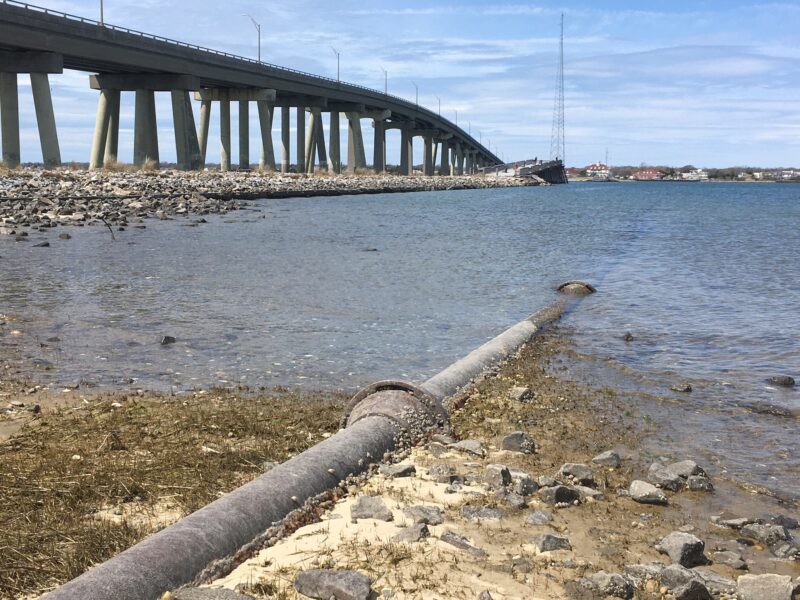
The news came as a surprise, a very welcome one, to James Kappers, assistant superintendent of the Hampton Bays Water District: a sizable Water Infrastructure Improvement Act grant from New York State is on tap for the district.
Some $2.72 million will go toward two directional drilling projects that are due to begin this year.
“This is definitely a big win for us, the town, and the customers in the water district,” Kappers said this week.
Late last year, the Southampton Town Board, acting as water district commissioners, voted to bond $4.5 million for the two projects.
Set to commence this May, the first directional drilling project entails the installation of approximately 3,400 linear feet of 12-inch water main about 25 feet below the channel bed, under Shinnecock Bay. It will replace an existing 8-to-10-inch concrete-lined ductile iron water main.
The proposed water main replacement is required by Suffolk County Department of Health Services to serve as a permanent replacement to the existing 8-inch underwater crossing; the department required the replacement by March 2022.
In 2019, the main, which ran parallel to the north side of the Ponquogue Bridge, broke when it was clipped by a dredge, and in 2018, the same main sprung a leak.
The main feeds Dune Road and — due to orders from the Health Department — there’s an urgency to completing the project.
Equipment staging will take place on the paved surfaces at Warner Marine Park and Old Lighthouse Road, according to application documents. The installation is expected to take about two months.
The goal of the second project is to improve water flow through a new water main under the Shinnecock Canal at Meschutt Beach. It is of less pressing need, but mobilizing the equipment for directional drilling is expensive, so officials felt it would be more economical to undertake the second project at the same time. This one is due to begin in August, Kappers said.
In 2020, the town adopted a 10-year master plan for the district. Together, all the projects needed for upgrading aging infrastructure added up to between $20 million and $30 million, Kappers noted.
“This is a big chunk of that money,” he said.
Councilman Rick Martel agreed. “This is an important part of the water district’s 10-year plan. With the help of this $2.7 million WIIA state grant the district will pay for most of the subaqueous crossing projects at the Shinnecock Canal and Shinnecock Bay. This is a great savings to rate payers and shows the dedication of the district’s employees to giving the best service at competitive rates.”
Kampers echoed the latter sentiment, noting, “We promised the people of Hampton Bays to do everything in our power to save them money.”
The Hampton Bays Water District is one of the smallest entities, and the only one on the East End, to receive grants from the nearly $601 million in WIIA grants Governor Kathy Hochul announced this week. Only four other individual independent water districts in Suffolk County received awards. The Suffolk County Water Authority received a number of grants for 12 separate projects upisland.
The WIIA has played a critical role across the state in ensuring that New Yorkers have clean water to drink, State Assemblyman Fred W. Thiele Jr. explained. “The program has been of particular assistance to our local governments across the South Fork dealing with PFAS, PFOA and other emerging chemicals by providing funding to extend public water to contaminated areas,” he noted.
In 2020, the Suffolk County Water Authority and the Town of Southampton announced the completion of installation of more than 10,800 feet of new water main in East Quogue, connecting up to 115 homes formerly using private wells impacted by PFAS contamination.
Perfluorooctanesulfonic acid (PFOS) and Perfluorooctanoic acid (PFOA), known together under the umbrella of PFAS, are fluorinated organic chemicals used in treatments to protect carpets, clothing, furniture fabrics, paper packaging for food and non-stick cookware. They are also found in firefighting foams. These compounds leach into the aquifer over time, contaminating Long Island’s sole source of drinking water.
“The award of $2.724 million from WIIA to the Hampton Bays Water District is the latest example of the state program providing funding to my district to improve water infrastructure. Not only does the program insure clean water for Hampton Bays, it also reduces the property tax impact of making these critical improvements,” Thiele said.
“Modernizing our state’s water infrastructure is critical to ensuring every New Yorker has access to clean drinking water,” Hochul said in a release announcing the grants, the largest-ever award of WIIA grants. “Protecting the public health of New Yorkers will always be a top priority for my administration and this funding is a testament to that commitment. We will continue working collaboratively with every level of government to empower localities with the funding they need to improve water quality statewide.”
In all, on April 19, Hochul announced water grants totaling $638 million in Environmental Facilities Corporation grants to municipalities and public authorities for 199 water infrastructure projects across the state that protect public health or improve water quality, nearly $601 million in WIIA grants and over $37 million in additional federal subsidies that will support approximately $1.6 billion in total infrastructure investment statewide.
WIIA provides competitive grants to help underwrite water quality infrastructure projects. WIIA grants can be put toward wastewater and drinking water projects that protect or improve water quality and/or protect public health. Municipalities may submit applications for multiple projects, including wastewater, sewer and drinking water projects.
The spring flushing of the HBWD water mains was slated to begin on the evening of April 24 and continue until May 6.
Officials recommend customers check the clarity of their water before using it. If it’s discolored, they say running it for several minutes should clear it. If not, district officials suggest waiting a few minutes, then trying again.
If that doesn’t work, call the district at 631-738-0179.